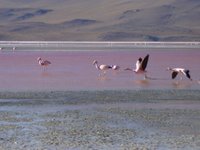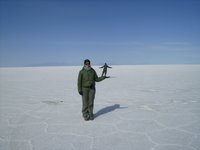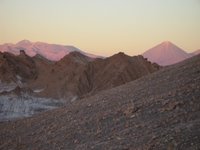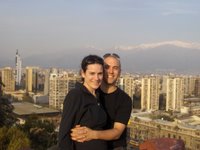
We left San Pedro on Sunday morning to begin a three day tour across the northern part of the Atacama desert to the most remote parts of Bolivia, finishing with the 12,000m squared salt lake - Salar de Uyuni.
First we entered Bolvia effortlessly with our Bolvian guides and had breakfast at the frontere whilst we changed from a bus to a 4x4 so we could cross the Bolivian roads, which are nothing more than tyre tracks across a rocky surface. This made for good fun, bouncing up and down across the rocks, something we would need to get used for the next few days.
The colours along the way were fascinating. The landscape was made up of deep, orangey brown plains with volcanos pushing through up to 6000m, and occasionally spurting out fumes. Often at the foot of these were lakes littered with various colours from the mineral rich landscape. The first of these lakes was a white lake, tinged at the edges with salt deposits. The second lake sat at the foot of Licancabur volcano and as the wind blew, the mineral content was swirled up causing a dramatic shift in the colour of the water from a greyish blue to a bright, vivid turquoise green, right before our eyes. Our next lake was littered with bright pink flamingos contrasting with pale turquoise water and a dusting of white salt around the edges. Truely awe-inspiring. The highlight here was the thermal springs that Stuart could not resist and so he stripped off and took a dip, whilst I gazed at the flamingos in awe. Little did we know that this was not going to be our only encounter with the pretty, pink birds.
Before lunch our journey took us past a field of geysers which spat out strong sulfuric fumes and plumes of steam. Viewing them from upwind (thankfully), we could get as close as we liked. There seems to be little health and safety in Bolvia, to point that we easily have fallen in and Barbara, our Swiss tour buddy had boiling hot mud splattered up her trousers! Again, the landscape was littered with orangey colours from old lava fields to the yellow hue of sulpher lines through the rocks.
We arrived at our lunch venue, a basic home-stay by Lake Colorado. These were the only people we had seen since the border crossing and it turned out this was to be our home for the night. After our late lunch we were driven to the lake, which was red in colour from a rich source of plancton. This was also home to hundreds of flamingos that feast here on the plancton and several herds of llamas, reasonably unfazed by tourists, especially silly ones like Stu!
What was really nice about this tour is that every site we encountered, we were the first there and our tour had their own special look-out spots, which were always spectacular points. This a dry, barron and incredibly inhospitable land, but rich in spectucular scenery.







